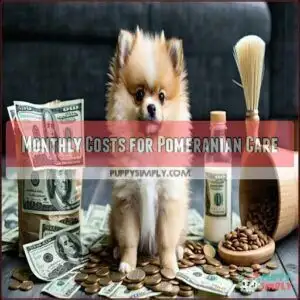This site is supported by our readers. We may earn a commission, at no cost to you, if you purchase through links.
 Pomeranians usually cost between $500 and $2,000, depending on factors like breeder reputation, location, and the dog’s pedigree.
Pomeranians usually cost between $500 and $2,000, depending on factors like breeder reputation, location, and the dog’s pedigree.
If you’re after a show-quality Pomeranian or one with exceptional lineage, prices can soar to $5,000 or more.
Keep in mind, though, the purchase price is just the beginning—you’ll also need to budget for essential supplies, vet care, and grooming.
Their fluffy coats might make you fall in love, but they’ll also keep you busy with maintenance.
For a more affordable option, consider adopting from a rescue. Owning a Pomeranian carries costs, but their adorable personalities make it feel priceless.
Table Of Contents
- Key Takeaways
- Pomeranian Puppy Prices
- Initial Costs of Pomeranian Ownership
- Monthly Costs for Pomeranian Care
- Ongoing and Recurring Costs
- Additional Costs to Consider
- Saving Money on Pomeranian Care
- Pomeranian Lifetime Costs and Benefits
- Frequently Asked Questions (FAQs)
- How much does a Pomeranian dog cost?
- Why are Pomeranians so expensive?
- How much does it cost to adopt a Pomeranian?
- How much does it cost to raise a Pomeranian?
- How much does it cost to groom a Pomeranians?
- How much does it cost to maintain a Pomeranian?
- Why are Pomeranian dogs so expensive?
- What is the cheapest price for a Pomeranian?
- Is Pomeranian a good pet?
- What color Pomeranian is the most expensive?
- Conclusion
Key Takeaways
- You’ll spend anywhere from $500 to $6,000 on a Pomeranian, depending on factors like the breeder, coat color, and pedigree, while adoption costs range from $300 to $650.
- Grooming, vet care, food, and supplies mean you’ll spend about $1,000 to $3,200 yearly, with monthly costs averaging $216 to $948.
- Rare coat colors like merle or lavender can make Pomeranians more expensive, while ethical breeders charge more for health guarantees and quality breeding.
- Adopting from a shelter is a more affordable option, often costing $50 to $650, and includes many benefits like vaccinations and spaying or neutering.
Pomeranian Puppy Prices
When you’re looking for a Pomeranian puppy, prices can range widely depending on the breeder, pedigree, and other factors.
Understanding what influences these costs helps you make an informed decision and budget accordingly, considering the breeder and other key elements.
Factors Affecting Price
The Pomeranian price range spans $500 to $6,000, influenced by coat color, lineage pedigree, and age factors.
Rare hues like merle or lavender push costs higher, while show-quality pups fetch premium prices.
Younger puppies often cost more than adults.
Breeder reputation also plays a big role—trusted breeders guarantee better health, which increases the pomeranian puppy price accordingly.
Quality and Health
Healthy puppies come from responsible hands! Quality isn’t a splurge—it’s protection.
Investing in a healthy puppy means investing in love, joy, and a lifetime of companionship.
Reputable breeders prioritize genetic screening, shielding your pup from common ailments like luxating patellas. Avoid puppy mills; they cut corners, risking your dog’s health.
Look for ethical breeding practices and health guarantees, as these guarantee fewer surprise vet bills.
-
Checklist for Quality:
- Proper health screenings
- Ethical breeder reputation
- Clear health records
Location and Time of Year
Where you live impacts Pomeranian prices.
In bustling cities, expect higher costs due to Regional Pricing. Rural areas often have lower pomeranian costs, but travel expenses might add up.
Seasonal Demand also plays a role—spring often sees a spike in prices. For savings, buy during winter when demand drops.
Location influence and timing are key Pomeranian cost factors.
Breeder Experience and Reputation
A breeder’s reputation can say a lot about the pup you’ll bring home.
Look for ethical breeding practices, health guarantees, and breeder transparency. Reputable Pomeranian breeders typically have kennel club certifications and great customer reviews.
-
Key traits of reputable breeders:
- Health screenings for genetic issues
- Show experience and breed expertise
- Detailed contracts with guarantees
- Stellar past customer feedback
Coat, Sex, and Age
Picking the perfect Pomeranian involves thinking about coat color rarity, sex differences, and age.
Rare coat colors, like merle or lavender, can boost prices, while females often cost slightly more due to breeding potential.
Puppies top the price chart compared to adults, but they come with higher initial care needs.
Coat maintenance also adds to ongoing expenses—darker coats sometimes require extra grooming.
Remember, the season matters too; springtime demand tends to nudge puppy prices higher.
Plan wisely! For those seeking a smaller companion, be aware that the term "teacup pomeranian" refers to ultra-small Pomeranians, not a separate breed.
Initial Costs of Pomeranian Ownership
When you bring home a Pomeranian, the initial costs can add up quickly with essentials like a bed, crate, and food bowls.
Healthcare, vaccinations, microchipping, and licensing are also important expenses to keep in mind.
Initial Setup and Supplies
Get ready for a happy homecoming with your puppy by gathering key supplies.
Start with a cozy crate and soft bed—your pup’s personal retreat. Durable food bowls prevent messes during meal times. A comfy collar and leash combo guarantees safe walks.
Don’t forget initial toys to keep them entertained and distracted. A suitable crate size is important, so research a puppy crate’s dimensions.
-
Must-haves:
- Sturdy food and water bowls
- Crate with bedding
- Chew-proof toys
Healthcare and Vaccinations
Your Pomeranian’s first year of veterinary care will cost about $590.
This includes core pet vaccinations, wellness exams, and preventative care like flea/tick meds.
Routine checkups detect common illnesses early, keeping your pup healthy.
Staying on track with vaccination schedules guarantees a happy, long life.
Think of it as brushing your teeth—essential for health, even if it’s not thrilling!
Spaying or Neutering
Spaying or neutering your Pomeranian isn’t just about avoiding unexpected litters—it’s an investment in their well-being.
Surgical costs typically range from $100 to $300, bringing lifelong health benefits:
- Lowers cancer risks and other medical expenses.
- Reduces behavioral issues like marking and aggression.
- Minimizes roaming, keeping your pup safer.
- Quick recovery process for most healthy pups.
Microchipping and Licensing
After spaying or neutering, microchipping guarantees your dog’s safety if they ever wander off.
Most microchips cost $25–$50, and dog licensing fees run $10–$20.
Here’s a quick breakdown:
| Item | Price Range |
|---|---|
| Microchip Cost | $25–$50 |
| Dog License | $10–$20 |
| Tracking Benefits | Priceless |
| Legal Requirements | Covered! |
Keep your furry friend safe and legal with these small, smart investments!
Monthly Costs for Pomeranian Care
Taking care of a Pomeranian isn’t just about cuddles—it comes with monthly costs you’ll need to plan for.
From food and grooming to vet visits and insurance, these expenses can add up quickly if you’re not prepared.
Food and Treats
In the context of food and treats, focus on your pup’s dietary needs and portion control.
Offer 1-2 cups of balanced dog food daily, and mix in treat varieties like veterinarian-approved chews or homemade options, such as sweet potato snacks.
Watch for food allergies, stick to nutritious choices, and keep snacks occasional to maintain their health and your wallet.
Many owners also consider insurance for genetic issues to help manage unexpected veterinary costs.
Grooming and Hygiene
Managing monthly grooming keeps your Pom looking sharp without breaking the bank.
Their fluffy coats need regular attention, but it’s not rocket science!
- Coat Brushing: Brush a few times a week to reduce shedding and tangles—a great bonding moment.
- Bath Frequency: Bathe every 3-4 weeks, keeping fur shiny and fresh.
- Nail Trimming & Dental Hygiene: Clip nails monthly and brush teeth often to avoid painful issues.
Consider using specialized dog shampoo for Pomeranians.
Consider DIY grooming to save!
Medications and Vet Visits
Pomeranians need regular vet visits and preventative care.
Vaccination schedules, dental cleanings, and flea treatments protect them from common ailments and costly emergency vet bills.
Routine veterinary care ranges from $50-$250, vaccinations cost $25-$75, and pet medications like flea prevention run $120-$300 yearly.
Staying consistent saves pets from discomfort—and your wallet from surprise expenses, which is crucial for their overall well-being and preventative care.
Pet Insurance and Emergency Fund
Pet insurance and an emergency fund protect against unexpected vet expenses.
Here’s how:
- Insurance Coverage: Covers accidents, illnesses, and costly treatments.
- Emergency Savings: A backup for veterinary emergencies beyond insurance.
- Policy Types: Choose deductibles explained clearly in pet insurance plans.
- Claim Process: Guarantee efficiency when filing for emergency vet bills.
Peace of mind helps you stay prepared!
Ongoing and Recurring Costs
Owning a Pomeranian means you’ll have regular expenses to keep your pup happy and healthy.
From vet visits to grooming and toys, these costs can add up over time but are essential for their care.
Annual Check-Ups and Vaccinations
Keeping your Pomeranian healthy starts with routine veterinary expenses like annual check-ups and vaccinations.
A solid vaccination schedule prevents surprises, while yearly physical exams catch potential issues early.
Expect core vaccinations to cost $25–$75 per dose, with booster shots ranging from $25–$50.
Annual vet visits cost $50–$250 but save you long-term, think of it as investing in your pet’s health and happiness—it’s worth every penny.
Parasite Prevention and Dental Care
In terms of parasite prevention, heartworm prevention, flea control, and tick prevention are non-negotiable.
These products keep your Pom safe from dangerous pests.
Dental cleaning is another must, but home dental care using toothbrushes and dental chews can trim costs.
Regular veterinary care, including vaccinations, guarantees your pet’s health stays on track.
Investing in prevention now saves on treatment later.
Training and Socialization
Training your Pomeranian early with positive reinforcement builds good habits and tackles behavioral issues before they grow.
Socialization is just as essential—introduce your pup to new people, dogs, and places to boost their confidence.
Obedience classes offer great value, blending dog training and dog socialization, while long-term benefits of a well-behaved companion are priceless!
Toys and Chews
Your Pomeranian’s teething phase can test your patience, but chew toy safety and smart choices help.
Opt for durable toy materials like rubber or nylon, or explore homemade toys using recycled materials.
Mix in puzzle toy options for mental stimulation and dental chews for healthier teeth.
Consider purchasing long-lasting chew toys for your energetic pup.
Regularly rotate toys to battle pet boredom and keep them excited about playtime.
Additional Costs to Consider
Owning a Pomeranian means planning for extra costs beyond the basics. From daycare and boarding to emergency vet bills, it’s smart to have a budget for the unexpected.
Dog Walking and Daycare
A Pomeranian’s energy can make dog walking essential.
Professional walkers charge $15-$25 per stroll, balancing exercise needs and your schedule.
Daycare prices vary but offer significant socialization impact through play.
To save, consider petsitting services or a trusted neighbor.
Whether you pick a dog walker or daycare, guarantee your fluffy companion gets the care they need to stay happy and healthy.
Boarding and Travel
When planning a getaway, factor in boarding costs and travel needs for your Pomeranian.
Pet boarding facilities and petsitting services can range from $20–$30 daily. For travel, invest in comfy travel carriers.
Flying? Pet passports and travel insurance are essential.
Vacation planning? Make certain pet-friendly hotels and rest stops cater to safety and comfort. A smooth trip requires preparation!
Remember to budget for ongoing preventative care to keep your Pomeranian healthy while you’re away.
Emergency Vet Visits and Surgery
Unexpected dog health emergencies can hit hard.
Emergency vet visits range from $250 to $1,000+, while surgical procedures may cost $1,500 to $5,000.
Accident coverage from pet insurance can ease financial worries.
Preventative measures like regular check-ups help avoid surprises.
Focus on pet health maintenance; investing in their well-being today saves stress and money tomorrow—your furry companion is worth it, considering the potential cost of emergency vet visits.
Pet Deposits and Fees
Managing landlord policies on pet deposits can feel like solving a tricky puzzle.
Rental agreements often include refundable or non-refundable fees for Damage Coverage or Breed Restrictions.
Ask about Deposit Alternatives or refund terms to lower your Pomeranian ownership cost.
Clarifying these details helps avoid surprises, keeping the pomeranian cost manageable while ensuring their adorable presence fits safely within your budget.
Saving Money on Pomeranian Care
You don’t have to spend a fortune to care for your Pomeranian while keeping them happy and healthy.
By making smart choices like adopting, grooming at home, and planning ahead, you can cut costs without cutting corners.
Adopting From Shelters or Rescues
Adopting through Pomeranian rescues or shelters is affordable and heartwarming. Adoption fees typically support the rescue benefits while providing dogs already vaccinated, spayed or neutered, and sometimes microchipped.
Adult Poms and mixed breeds are often available, offering a calm and loyal companion. Rescue pets thrive in a loving home and keep costs lower.
- Support a shelter environment.
- Save on healthcare.
- Enjoy a simpler adoption process.
- Provide a home for Adult Poms.
- Discover unique mixed breeds.
Purchasing High-Quality Supplies
Why skimp on essentials when high-quality pet supplies make life easier? Invest in durable toys, safe bedding, and premium food to avoid replacing items constantly.
A sturdy dog bed and effective training tools guarantee comfort and control. Pair quality grooming brushes with bowls that don’t tip over.
Spending a little extra upfront means happier pups and fewer headaches for you later!
Grooming at Home
Keeping your Pomeranian tidy at home isn’t just thrifty—it’s fun!
Regular brushing techniques every few days keep their coat shiny and snag-free.
A monthly bath helps maintain proper bathing frequency while cutting grooming costs.
Don’t skip essentials like nail trimming, ear cleaning, and dental hygiene for their overall health.
With DIY pet grooming tips and love, home pet coat care is manageable—and rewarding!
Investing in Pet Insurance
Home grooming saves cash, but pet insurance is your backup for life’s surprises.
It tackles pricey vet bills and protects your wallet.
Top perks of pet insurance:
- Policy Coverage and Costs: Manageable premiums cover emergencies, surgeries, or accidents. Deductibles explained in simple terms!
- Claim Process: Hassle-free claims streamline big expenses tied to Pomeranian prices or unexpected costs.
Pomeranian Lifetime Costs and Benefits
When you bring a Pomeranian into your life, it’s important to understand the long-term costs and rewards.
From upfront expenses to the joy of their companionship, owning one is a financial commitment that’s worth every penny, considering the companionship.
Estimated Lifetime Cost
A Pomeranian’s lifetime cost can climb as high as $55,000.
Don’t panic—proper financial planning makes it manageable. Break it down: factor in food, grooming, vet care, and unexpected expenses like emergencies or training.
Think of your Pomeranian as a priceless long-term investment in joy and companionship. With smart budgeting, those lifetime expenses feel like an achievable goal, not a surprise.
Benefits of Pomeranian Ownership
Pomeranians bring big joy in a fluffy, tiny package.
Full of personality and love, Pomeranians pack boundless joy into their small, fluffy frames.
Their playful nature keeps things lively, while their loyalty makes them perfect companions.
These dogs are great for families, offering unconditional emotional support and helping reduce stress.
- Travel-friendly size: Easy to take anywhere without hassle.
- Great for bonding: Strengthens connections through shared care.
- Active lifestyle fit: Keeps you on your toes with fun activities.
Why Pomeranians Are Worth The Investment
For their loyalty and companionship, Pomeranians are a joyful presence worth every penny.
Sure, the pomeranian cost can feel steep, especially for pomeranian puppies from top breeders, but their family affection and unique personality make them priceless.
They offer emotional support and brighten your days.
An expensive Pomeranian isn’t just a pet, it’s a tiny, lovable family member. Given their breed predispositions, considering Pomeranian pet insurance is a wise decision.
Frequently Asked Questions (FAQs)
How much does a Pomeranian dog cost?
You’re looking at a price range of $500 to $6,000 for a Pomeranian, depending on factors like pedigree, coat color, and breeder reputation. Adoption costs are much lower, typically between $300 and $
Why are Pomeranians so expensive?
You’re paying for their tiny size, fluffy coat, and charm, but quality breeding also adds to the price.
Rare colors, reputations, and health guarantees drive costs higher, ensuring you get a healthy, well-bred companion.
How much does it cost to adopt a Pomeranian?
Adopting a Pomeranian costs $300 to $650 from rescues or shelters, but it can vary.
Prices might go lower for older dogs or mixed breeds.
You’re paying for love, not just fur and fluff!
How much does it cost to raise a Pomeranian?
Raising a Pomeranian is like budgeting for a pint-sized superstar. Expect to spend $1,000–$3,200 annually on food, grooming, and healthcare, plus $1,000–$1,700 for initial supplies. Monthly costs average $216–$948, depending on lifestyle.
How much does it cost to groom a Pomeranians?
Grooming a Pomeranian typically costs $30 to $90 per session, depending on coat condition and salon location.
Regular grooming helps maintain their fluffy coat, prevents matting, and keeps them looking like the little divas they are, which is a key part of their overall grooming.
How much does it cost to maintain a Pomeranian?
Maintaining a Pomeranian costs around $1,000 to $3,200 yearly, covering food, grooming, toys, and vet care. Monthly expenses average $216 to $948, but their small size helps keep some costs manageable.
Why are Pomeranian dogs so expensive?
Pomeranians are pricey because of their small size, rare colors, and high demand.
Breeders invest heavily in health testing, quality bloodlines, and care.
Plus, their adorable looks and charming personalities drive up their value.
What is the cheapest price for a Pomeranian?
Finding a Pomeranian for the price of a cup of coffee might seem like a dream, but rescue shelters sometimes offer them for as little as $
Making them an affordable and loving option.
Is Pomeranian a good pet?
You’ll love having a Pomeranian if you enjoy small, lively dogs with big personalities.
They’re loyal, affectionate, and playful, but require regular grooming and socialization.
Their charm makes them fantastic companions for the right owner.
What color Pomeranian is the most expensive?
You’d better sit down for this—rare coats like white, lavender, or merle will cost you a pretty penny.
These unique colors can fetch top dollar, often surpassing the price of standard Pomeranian coats.
Conclusion
Thinking about how much Pomeranians cost beyond just the purchase price?
These adorable pups come with expenses like grooming, vet care, and supplies, but their charm makes it worth it.
Whether you buy a pup from a breeder or adopt from a shelter, you’ll need to budget wisely for their lifetime care.
With proper planning and love, owning a Pomeranian can be a rewarding experience that’s priceless.
Are you ready for the commitment and cuddles?
- https://dogo.app/how-much-does-a-pomeranian-cost/
- https://pomeranian.org/blog/2023/06/13/pomeranian-price/
- https://www.quora.com/How-much-do-Pomeranians-typically-cost-and-where-can-someone-find-one-for-cheaper-than-retail-prices
- https://www.dogster.com/dog-breeds/how-much-does-it-cost-to-own-a-pomeranian
- https://www.reddit.com/r/Pomeranians/comments/106o6w4/question_about_pomeranian_cost/




















